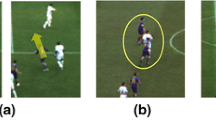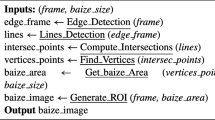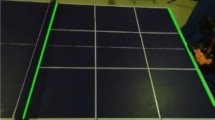Abstract
This paper presents a new high-speed object tracking algorithm and applies it in tracking high-speed golf balls. Several challenges are encountered in tracking this kind of small-size and high-speed objects; these challenges include: (1) the motion speed (up to 200km/h) of the object is extremely fast that the image captured by the camera can become easily blurred; (2) the size of the objects is small and there is not enough texture feature on the surface of the objects; (3) high-speed objects typically move in outdoor environments, which have complex backgrounds and the light conditions; and (4) a balance between robustness and real-time efficiency is difficult to achieve. There is no existing method can directly solve all these problems. To address these problems, a novel real-time visual tracking algorithm and system are developed that can realize high-speed small object tracking and trajectory predication. The frame difference method was employed to segment the moving objects from the background. The motion blurred object can be detected by applying the proposed object recognition method using multi-features (geometry features and object motion features). Different from the state of the art tracking algorithms, the motion blurring feature was also considered as a feature of the high-speed object, and the tracking robustness of the proposed algorithm does not rely on the texture feature of the tracking objects. To realize real-time efficiency, a region of interest predicting and updating method was proposed that can shrink the processing area of the frames and achieve a high frame rate. Combining visual servoing technology and aerodynamics, the trajectory of the high-speed object can be predicted. The high-speed golf ball tracking experiments were conducted to demonstrate the tracking efficiency and robustness of the algorithm.














Similar content being viewed by others
References
Chakraborty B, Meher S (2013) A trajectory-based ball detection and tracking system with applications to shooting angle and velocity estimation in basketball videos. In: 2013 Annual IEEE India conference (INDICON), pp 1–6
Yu X, Leong HW, Xu C, Tian Q (2007) Trajectory-based ball detection and tracking in broadcast soccer video. IEEE Trans Multimed 8(6):1164–1178
Zhou X, Xie L, Huang Q, Cox SJ (2015) Tennis ball tracking using a two-layered data association approach. IEEE Trans Multimed 17(2):145–156
Ariki Y, Takiguchi T, Yano K (2008) Digital camera work for soccer video production with event recognition and accurate ball tracking by switching search method. In: 2008 IEEE international conference on multimedia and expo, pp 889–892
Shum H, Komura T (2005) Tracking the translational and rotational movement of the ball using high-speed camera movies. In: IEEE international conference on image processing, ICIP 2005, pp III -1084–7
Gu W-K, Wang D-Wei, Ma X-Yan (2014) High speed moving target detection using distributed ofdm-mimo phased radar. In: 2014 12th international conference on signal processing (ICSP), pp 2087–2091
Nakashima A, Ogawa Y, Liu C, Hayakawa Y (2011) Robotic table tennis based on physical models of aerodynamics and rebounds. In: 2011 IEEE international conference on robotics and biomimetics (ROBIO), pp 2348–2354
Liu C, Hayakawa Y, Nakashima A (2011) A registration algorithm for on-line measuring the rotational velocity of a table tennis ball. In: 2011 IEEE international conference on robotics and biomimetics (ROBIO), pp 2270–2275
Acosta L, Rodrigo JJ, Mendez JA, Marichal GN, Sigut M (2004) Ping-pong player prototype. IEEE Robot Autom Mag 10(4):44–52
Chen X, Huang Q, Wan W, Zhou M, Zhangguo Y, Zhang W, Yasin A, Meng F (2015) A robust vision module for humanoid robotic ping-pong game. Int J Adv Robot Syst 12(35):1–14
Glover J, Kaelbling LP (2014) Tracking the spin on a ping pong ball with the quaternion bingham filter. In: 2014 IEEE international conference on robotics and automation (ICRA), pp 4133–4140
Lyu C, Liu Y, Li B, Chen H (2015) Multi-feature based high-speed ball shape target tracking. In: 2015 IEEE international conference on information and automation
Zhang Z (1999) Flexible camera calibration by viewing a plane from unknownorientations. In: Iccv, p 666
Hu MK (1962) Visual pattern recognition by moment invariants. IRE Trans Inf Theory 8(2):179–187
Migliore DA, Matteucci M, Naccari M (2006) A revaluation of frame difference in fast and robust motion detection. In: Proceedings of the 4th ACM international workshop on Video surveillance and sensor networks, pp 215–218
Celik T (2010) Change detection in satellite images using a genetic algorithm approach. IEEE Geosci Remote Sens Lett 7(2):386–390
Stockman G, Shapiro LG (2001) Computer vision. In: Oe Lase87 and Eo Imaging Symp, p 31C40
Zunic J, Hirota K, Rosin PL (2010) A Hu moment invariant as a shape circularity measure. Pattern Recognit 43(1):47–57
Yoon YH, Jo KH (2003) Hands shape recognition using moment invariant for the korean sign language recognition. In: Proceedings KORUS 2003. The 7th Korea–Russia international symposium on science and technology, vol. 2, pp 308–313
Lowe DG (1999) Object recognition from local scale-invariant features. In: The proceedings of the seventh IEEE international conference on computer vision, 1999, vol. 2, pp 1150–1157
Bay H, Tuytelaars T, Van Gool L (2006) Surf: speeded up robust features. Comput Vis Image Underst 110(3):404–417
Nonomura J, Nakashima A, Hayakawa Y (2010) Analysis of effects of rebounds and aerodynamics for trajectory of table tennis ball. In: Proceedings of SICE annual conference 2010, pp 1567–1572
Zhang K, Zhang L, Yang MH (2012) Real-time compressive tracking. In: European conference on computer vision, pp 864–877
Comaniciu D, Meer P (2002) Mean shift: a robust approach toward feature space analysis. IEEE Trans Pattern Anal Mach Intell 24(5):603–619
Nouar OD, Ali G, Raphael C (2006) Improved object tracking with camshift algorithm. In: IEEE international conference on acoustics, pp II–II
Acknowledgements
The work was support by Grants from the Shenzhen Science and Innovation Committee [Reference No. JCYJ20140417172417145], and a Grant from the Guangdong Science and Technology Foundation [Reference No. 2014A010103007] and Shenzhen Peacock Plan Team Grant [KQTD20140630150243062], Shenzhen Key Laboratory Grant [ZDSYS20140508161825065], a Grant from the National Natural Science Foundation of China [Reference No. 61673131].
Author information
Authors and Affiliations
Corresponding author
Rights and permissions
About this article
Cite this article
Lyu, C., Liu, Y., Jiang, X. et al. High-Speed Object Tracking with Its Application in Golf Playing. Int J of Soc Robotics 9, 449–461 (2017). https://doi.org/10.1007/s12369-017-0404-0
Accepted:
Published:
Issue Date:
DOI: https://doi.org/10.1007/s12369-017-0404-0




